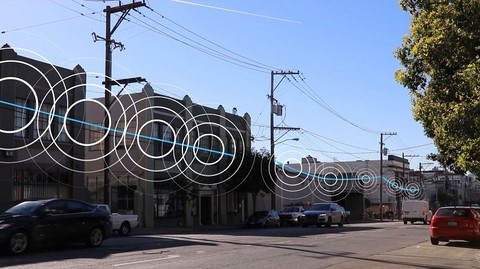Will small cells bring unlimited data to city streets or guerilla warfare?
 Image: Artemis Networks
Image: Artemis Networks
5G is coming. 4G is here. They both need more mobile cell sites—cell densification it’s called in the industry. Only 5G may need a 100 times more cells than 4G does. Micro-densification. Or pico-densification. And while most of these new cells will be indoors, like today’s WiFi routers, many will be outside. Today’s 4 million mobile cell sites around the world could become 400 million—and certainly 100 million—in the foreseeable future.
We will carry some of these sites around in our pockets like the portable WiFi routers available today. Many will be indoors. And where no above-ground utilities are allowed or no poles (even for lighting) are in sight, some may be embedded in person-holes, as we should call tomorrow’s manholes, connected by fiber cable through the underlying tunnels. But most outdoor 5G sites will be on the streets, plazas and roadways of cities from Chicago to Cape Town, Stockholm to Sydney.
So where will we place the hundreds of millions of outdoor micro, pico and femto cells of the 5G world to come? Battle lines are forming. In the United States utility companies are trying to wrest control of utility poles from telephone operators and cities. Public interest groups are calling for a holistic, single infrastructure approach. And mobile operators are supporting legislation in 20+ states to keep the cities out. In Europe, where fewer poles exist, lighting and CCTV systems are being targeted, yet strict EU lighting pole rules may stand in the way.
Behind the scenes guerrilla warfare is breaking out. Utility poles, where they exist and whatever purpose they now serve, are being seen as strategic assets for the placement of the Remote Radio Heads (RRH) of tomorrow. But how to solve the ownership and rights to the limited number of poles in place and the new poles that will need to be built? Perhaps the answer is a PPPP or P4? A Public Private Partnership for Poles (5G poles). In earlier days in the U.S. the phone companies, utilities and cable TV operators fought in state legislatures for setting rules and rates for pole attachments. But this took more than a decade to sort out. Would a P4-5G streamline or encumber this process? The issues are not just who will get to use the poles for how much but also environmental concerns, pole placement and installation, public safety, and aesthetic and stress concerns.
Will the pole in front of your house start to look like a three-stage NASA probe, some ask, with noise emanating from the fans in the power console at its base? Will the pole’s boxes capture data about everything going on in the neighborhood, not to mention nearby offices? Perhaps a PPPP wouldn’t be a bad idea. Not one that puts a single entity in control, whether the government or the biggest electrical utility but one that creates a multi-stakeholder structure to resolve issues and provide governance as the new “pole attachment” dynamics unfold.
Let us know your reactions or any specific proposals you may have.